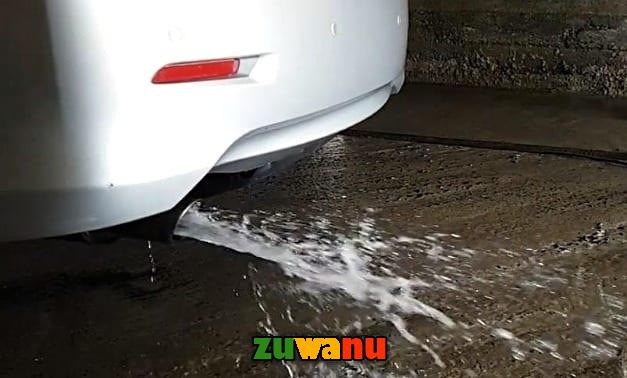Water Coming Out of Tailpipe While Running: Causes, Concerns, and Professional Advice
Experiencing water coming out of your car’s tailpipe while it’s running? Understand the causes, differentiate between normal condensation and coolant leaks, and find professional advice on what to do in this comprehensive article. Ensure your vehicle’s performance and address potential issues promptly.
Water Coming Out of Tailpipe While Running
Discover why water is coming out of your tailpipe while your engine is running. Learn about the primary cause, normal condensation, and how to differentiate it from coolant leaks. Find professional advice on maintenance, monitoring coolant levels, and seeking help for underlying issues. Ensure your vehicle’s optimal performance with this informative guide.

When you see water dripping from your car’s tailpipe while it’s running, it can raise a few questions and cause concerns. After all, why is there water coming out of the tailpipe, and is it something to worry about? In this comprehensive article, we will explore the causes behind water coming out of the tailpipe while the engine is running, discuss whether it is normal or a cause for concern, and provide professional advice on what users should know and do in such situations.
Table of Contents:
- Understanding the Role of the Exhaust System
- Normal Condensation: The Primary Cause of Water in the Tailpipe
- Water Vapor vs. Coolant Leaks: Differentiating the Two
- Concerns Regarding Excessive Water in the Tailpipe
- Professional Advice and What Users Should Know 5.1 Regular Maintenance and Inspection 5.2 Monitoring Coolant Levels and Color 5.3 Checking for Other Symptoms 5.4 Seeking Professional Help
- Conclusion
- Understanding the Role of the Exhaust System: To comprehend why water might be coming out of the tailpipe, it is crucial to understand the purpose of the vehicle’s exhaust system. The exhaust system is responsible for collecting and expelling harmful gases produced during the combustion process. It consists of various components, including the exhaust manifold, catalytic converter, muffler, and tailpipe.
- Normal Condensation: The Primary Cause of Water in the Tailpipe: In most cases, the water you observe dripping from the tailpipe is a result of condensation and is considered normal. The exhaust system generates a significant amount of heat, and when the engine cools down, the moisture in the air condenses on the inner surfaces of the exhaust system, including the tailpipe. This condensation appears as water droplets when the engine is running and the exhaust gases pass through the cooler tailpipe.
- Water Vapor vs. Coolant Leaks: Differentiating the Two: While condensation is the most common cause of water in the tailpipe, it is essential to differentiate it from other potential causes, such as coolant leaks. Coolant leaks are a more serious concern and require prompt attention. If the liquid dripping from the tailpipe is accompanied by a sweet smell, a thicker consistency, or an unusual color (e.g., green or pink), it is likely a coolant leak and should be addressed immediately.
- Concerns Regarding Excessive Water in the Tailpipe: While condensation is normal, excessive water coming out of the tailpipe may indicate underlying issues. Excessive water could be a sign of an internal coolant leak, such as a blown head gasket or a cracked engine block. Other possible causes include a malfunctioning thermostat, a damaged radiator, or an issue with the fuel mixture. If you notice a considerable amount of water or experience other symptoms like white smoke, overheating, or poor engine performance, it is advisable to seek professional assistance.
- Professional Advice and What Users Should Know: To ensure the optimal performance and longevity of your vehicle, it is essential to follow these professional tips and know what to do when water is coming out of the tailpipe:
5.1 Regular Maintenance and Inspection: Routine maintenance, including scheduled service intervals and inspections, plays a vital role in identifying and addressing potential issues promptly. Regularly check for leaks, unusual odors, and any signs of coolant mixing with engine oil.
5.2 Monitoring Coolant Levels and Color: Keep an eye on your vehicle’s coolant levels and its color. Coolant should be a consistent color (typically green or pink, depending on the type) and should not have an oil-like consistency or unusual odor. If you observe any abnormalities, it’s important to have your vehicle examined by a qualified mechanic.
5.3 Checking for Other Symptoms: Apart from excessive water in the tailpipe, be attentive to other symptoms that might indicate a more serious problem. These include white smoke from the tailpipe, overheating, coolant loss, engine misfires, or a sudden drop in fuel efficiency. Any of these symptoms warrant further investigation.
5.4 Seeking Professional Help: If you are unsure about the cause of water coming out of your tailpipe or are experiencing any concerning symptoms, it is best to consult a professional mechanic. They have the expertise and tools to diagnose the issue accurately and provide appropriate repairs.
- Conclusion: Water dripping from the tailpipe while your vehicle is running is typically a result of normal condensation. However, it is crucial to differentiate between condensation and coolant leaks to identify potential issues. Excessive water, along with other symptoms, can indicate underlying problems that require professional attention. By following regular maintenance, monitoring coolant levels, and promptly addressing any concerning symptoms, you can ensure your vehicle operates optimally and avoid further damage.
Remember, when in doubt, it is always advisable to seek professional advice. Your vehicle’s health and your safety on the road are paramount.
